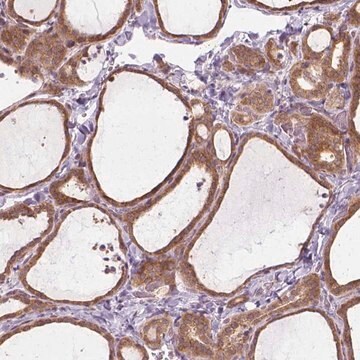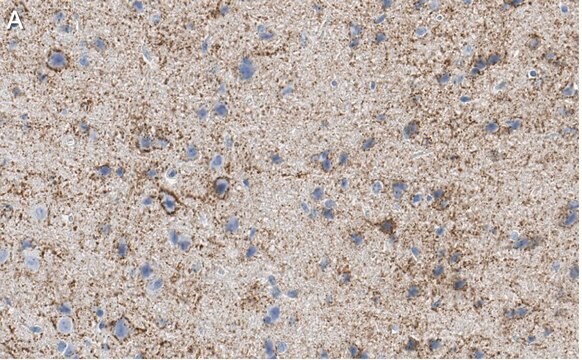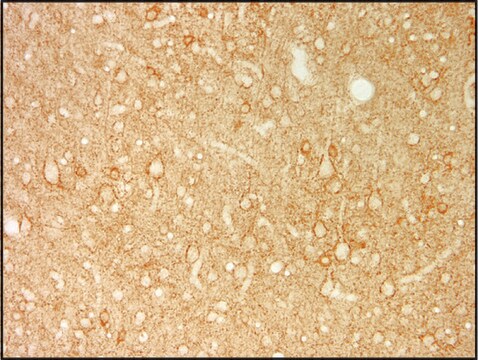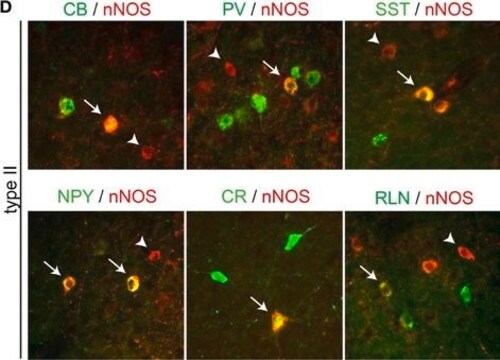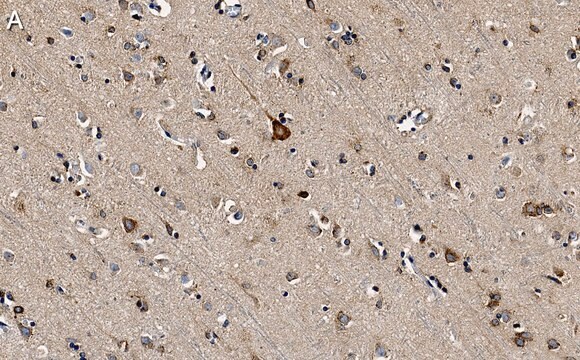推荐产品
生物源
rabbit
共軛
unconjugated
抗體表格
affinity isolated antibody
抗體產品種類
primary antibodies
無性繁殖
polyclonal
產品線
Prestige Antibodies® Powered by Atlas Antibodies
形狀
buffered aqueous glycerol solution
物種活性
human
技術
immunohistochemistry: 1:200- 1:500
免疫原序列
LNMLLQANDIRESSVEEDVEWYQALVRSVAEGDPRVYRALLTFNPPPGASHLQLALQATRTGEETILQDLSGNWVQEENPPGDLDTPALKKRVLTNDLGSLGSPKWPQADGYVGDTQQVRLSPPFLECQEGRLRPGWLITLSATF
UniProt登錄號
運輸包裝
wet ice
儲存溫度
−20°C
目標翻譯後修改
unmodified
基因資訊
human ... GPR179(440435)
一般說明
G protein-coupled receptor 179 (GPR179) is a 2367 amino acid orphan G protein receptor. It is expressed in all vertebrates and is part of the glutamate receptor or class C GPCR proteins. GPR179 contains an amino-terminal region with a calcium-binding epidermal growth factor (EGF)-like domain, a carboxyl-terminal region having a short motif and seven transmembrane domain regions. The gene encoding the protein is located on chromosome 17.
免疫原
Probable G-protein coupled receptor 179 Precursor recombinant protein epitope signature tag (PrEST)
應用
Anti-GPR179 antibody produced in rabbit, a Prestige Antibody, is developed and validated by the Human Protein Atlas (HPA) project . Each antibody is tested by immunohistochemistry against hundreds of normal and disease tissues. These images can be viewed on the Human Protein Atlas (HPA) site by clicking on the Image Gallery link. The antibodies are also tested using immunofluorescence and western blotting. To view these protocols and other useful information about Prestige Antibodies and the HPA, visit sigma.com/prestige. Anti-GPR179 antibody produced in rabbit has been used for enzyme-linked immunosorbent assay (ELISA).
生化/生理作用
G protein-coupled receptor 179 (GPR179) has a depolarizing bipolar cell (DBC) function. It takes part in the DBC signal transduction pathway for normal rod vision in the eye. Mutations in the gene encoding GPR179 have been linked to autosomal-recessive congenital stationary night blindness.
特點和優勢
Prestige Antibodies® are highly characterized and extensively validated antibodies with the added benefit of all available characterization data for each target being accessible via the Human Protein Atlas portal linked just below the product name at the top of this page. The uniqueness and low cross-reactivity of the Prestige Antibodies® to other proteins are due to a thorough selection of antigen regions, affinity purification, and stringent selection. Prestige antigen controls are available for every corresponding Prestige Antibody and can be found in the linkage section.
Every Prestige Antibody is tested in the following ways:
Every Prestige Antibody is tested in the following ways:
- IHC tissue array of 44 normal human tissues and 20 of the most common cancer type tissues.
- Protein array of 364 human recombinant protein fragments.
聯結
Corresponding Antigen APREST73311
外觀
Solution in phosphate-buffered saline, pH 7.2, containing 40% glycerol and 0.02% sodium azide
法律資訊
Prestige Antibodies is a registered trademark of Merck KGaA, Darmstadt, Germany
免責聲明
Unless otherwise stated in our catalog or other company documentation accompanying the product(s), our products are intended for research use only and are not to be used for any other purpose, which includes but is not limited to, unauthorized commercial uses, in vitro diagnostic uses, ex vivo or in vivo therapeutic uses or any type of consumption or application to humans or animals.
未找到合适的产品?
试试我们的产品选型工具.
儲存類別代碼
10 - Combustible liquids
水污染物質分類(WGK)
WGK 1
閃點(°F)
Not applicable
閃點(°C)
Not applicable
Isabelle Audo et al.
American journal of human genetics, 90(2), 321-330 (2012-02-14)
Congenital stationary night blindness (CSNB) is a heterogeneous retinal disorder characterized by visual impairment under low light conditions. This disorder is due to a signal transmission defect from rod photoreceptors to adjacent bipolar cells in the retina. Two forms can
Elise Orhan et al.
Investigative ophthalmology & visual science, 54(13), 8041-8050 (2013-11-14)
Mutations in GPR179, which encodes the G protein-coupled receptor 179, lead to autosomal recessive complete (c) congenital stationary night blindness (CSNB), which is characterized by an ON-bipolar retinal cell dysfunction. This study further defined the exact site of Gpr179 expression
Neal S Peachey et al.
American journal of human genetics, 90(2), 331-339 (2012-02-14)
Complete congenital stationary night blindness (cCSNB) is a clinically and genetically heterogeneous group of retinal disorders characterized by nonprogressive impairment of night vision, absence of the electroretinogram (ERG) b-wave, and variable degrees of involvement of other visual functions. We report
我们的科学家团队拥有各种研究领域经验,包括生命科学、材料科学、化学合成、色谱、分析及许多其他领域.
联系技术服务部门
